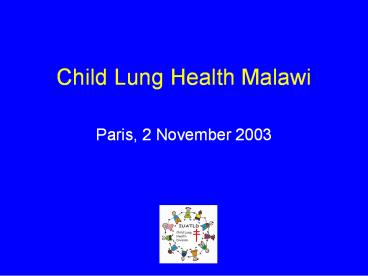Child Lung Health Malawi - PowerPoint PPT Presentation
1 / 30
Title:
Child Lung Health Malawi
Description:
IUATLD's Interest to support the ARI Program in Malawi? ... Malawi being part of the priority region for both IUATLD and the Gates Foundation. ... – PowerPoint PPT presentation
Number of Views:112
Avg rating:3.0/5.0
Title: Child Lung Health Malawi
1
Child Lung Health Malawi
- Paris, 2 November 2003
2
- Rationale for Developingthe Malawi Child Lung
Health Project
3
(No Transcript)
4
Background
- Estimated incidence of pneumonia in Africa
- - All cases 33 600 000 32 /
100 - - Severe cases 2 900 000 3 / 100
- Estimated mortality in Africa
- - Number 21 of all deaths (3,806,000)
800,000 - - Rate 152/1000 live births
- Main risk factors
- HIV/ AIDS (5 fold rise of TB cases since 1985)
- Malnutrition (50 stunted and 4 severe
malnutrition in Malawi) - Indoor air pollution
5
Why did Malawi decide to introduce the CLHP?
- Poor health indicators
- Lack of partners to provide financial support to
the ARI program - IMCI implementation under-way
- Inadequate capacity to manage severe pneumonia at
district hospital level
6
Poor Health Demographic Indicators
- Life Expectancy at Birth
- - Men
35.7 years - - Women 36.9
years - Infant mortality rate 104 / 1000
- Under 5 mortality rates 189 / 1 000 live
births - Maternal Mortality Ratio 1120/100,000 live
births
7
Inadequate Financial and Technical
Support to the ARI Program
- ARI Programme was established in 1985
- Separated from TB in 1995
- Slow progress for lack of resources
- Request to IUATLD for support in 1994
- IUATLD strived for funding for 5 years
8
Implementation of IMCI
- IMCI Strategy
- leads to
- early recognition of severe pneumonia
- early referral of severe cases to the
district hospital - Hence creates demand for efficient inpatient
paediatric care
9
Inadequate Capacity to Manage Severe Pneumonia
- Case fatality rate at about 19
- Inadequate skills
- Poor environment
- Inadequate drugs
- Poor data collection, collation, analysis and
utilization
10
IUATLDs Interest to support the ARI Program in
Malawi?
- Request was made to IUATLD for support in 1994.
- Successful implementation of the IUALTD model for
TB control in Malawi since 1985. - Malawi being part of the priority region for both
IUATLD and the Gates Foundation. - Concurrence with WHO on the need to improve
inpatient care for paediatric patients i.e. to
complement the outpatient IMCI strategy
11
Opportunities
- Government commitment
- Presence of the IUATLD ARI training manual
- Comprehensiveness of the IUATLD model
- Availability of the wonderful donor the Gates
Foundation
12
The IUATLD Model
- Key Elements
- Practical Training of staff
- Regular Supply lines
- Frequent Supervision
- Regular Monitoring through analysis of recording
and reporting data - Accountability and transparency
- External Evaluation
13
The main aim of the CLH Project
- To reduce mortality among paediatric inpatients
from pneumonia and other respiratory diseases by
maximising the benefits of Standard Case
Management through - Improvement of health workers practice through
training and active follow up - Directing limited resources to children most at
risk - Promoting rational use of antibiotics
- Promoting the culture of data generation and use
14
Summary
- Malawi had enough reasons to develop and
implement the CLHP - IUALTD had enough reasons to support the
development and implementation of the project - There were tremendous opportunities which created
a conducive environment for Malawi to implement
the project with minimal difficulty
15
Situation in Malawi 1999Access to Health Services
- 35 - 50 8 km from a health facility
- 50 do not utilize the facilities
- 24 of under fives die
- standard case management
16
Situation Analysis, 2000 Case Management in
Malawi
- Standardized case management introduced 1988
- Pneumonia accounted for 23 of hospital
admissions in first half of 1999 - In-hospital case fatality was up to 26
- No relation of fatality to grade of severity
17
Situation Analysis Conclusions
- Lung disease is a major killer of children
- Means exist to prevent the deaths
- These means are not reaching children
- Key obstacles are managerial
- The IUATLD strategy addresses these
18
Malawi Child Lung Health ProjectFunded by Bill
Melinda Gates Foundation
- Activities based at District Hospital
- Case management according to WHO
- Service provided in existing system
- Emphasis on supply, information, training and
supervision - District manager is a paramedic
19
Activities
- Training materials introduced in 2000
- Monitoring / information system introduced in
2000 - 300 Health Workers trained for 23 districts
- 6 monthly external evaluation carried out
20
Trend in Numbers of CasesOctober 2000 to
December 2002
3rd Training Course 6 districts
2nd Training Course 5 districts
1st Training Course 5 districts
2000 2001
2002
21
Distribution of CasesBy Age and Severity
Number
Age Group, Months
22
Trend in Successful TreatmentMalawi, 2000-2002
Months after program introduction
23
Trend in Fatality from Pneumonia
Months after program introduction
24
ExpendituresTotal
25
ExpendituresExternal
26
Running Costs from External Investment
27
Return on Investment
28
Return on Investment
200 deaths averted monthly
29
Summary
- Implementation of standard case management to
district hospitals is feasible and successful - Key elements for success are supply,
accountability and supportive visits - The cost is competitive, facilitating
sustainability
30
The Way Forward
- Non-governmental institutions to be enrolled
- Adoption of Child Lung Health into National
Planning (SWAPS) - Plan for post-project continuation to be
developed































